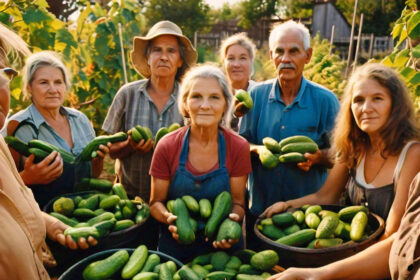Most plants or crops have a particularly optimal yield aside from the other seasons they produce. What month do you plant okra?
Okra, a warm-season vegetable prized for its tender pods, is popular in soups, stews, and frying for others. It is mostly known for its unique texture and high fiber content; it’s a nutritious addition to gardens.
Okra planting is considered best for a vital optimal in late spring to early summer. Soils with warm temperatures boost germination, growth, and flowering, leading to healthier plants and a more abundant harvest.
This guide will provide you with the right knowledge on how beginners need to determine the ideal planting time for okra, ‘ensuring optimal growth conditions’, and a successful, abundant yield. Also What month do you plant okra?
The Okra Plant: Description And Characteristics
Description of Okra Plant
Okra, a warm-weather vegetable, is valued for its tender green pods and is easy to grow in sunny, hot conditions.
Grow well in loamy, well-drained soil with a pH between 6.0 and 6.8. Okra needs temperatures above 65°F (18°C) for successful germination and growth.
It requires full sunlight and consistent watering but dislikes overly moist soil, which can lead to root rot.
Nutrient Availability
Nutritionally, okra is packed with fiber, vitamins C and K, and folate, making it a healthy addition to various dishes. The pods contain mucilage, a natural thickener that’s especially prized in stews, soups, and gumbo for creating a hearty, rich texture.
Okra is also enjoyed grilled, fried, and even pickled, offering a versatile flavor that complements many cuisines.
Okra Varieties and Uses
Several okra varieties cater to different tastes and gardening needs. Clemson Spineless is a popular choice due to its tender, spineless pods and high yield. ‘Burgundy’ offers a striking red pod and is both ornamental and edible.
Jambalaya is another variety known for its early production and compact growth, ideal for small spaces. Selecting the right variety can enhance both garden aesthetics and culinary uses.
Planting Conditions Required for Okra
Temperature for germination: Okra thrives when planted in warm soil, making soil temperature a critical factor for optimal growth. For successful germination, the soil must reach at least 65°F (18°C).
Okra grows best when soil temperatures consistently stay between 70-95°F (21-35°C), as warm conditions in the soil revitalize seedling development and help the plant produce abundant pods.
Soil Preparation and Type: Preparing the soil properly before planting okra is essential. Okra grows well in well-drained, loamy soil enriched with organic matter. This type of soil structure allows roots to penetrate deeply and promotes balanced moisture retention.
Soil pH is also crucial, as okra prefers a slightly acidic to neutral range of 6.0 to 6.8. If the soil is too acidic or alkaline, nutrient uptake can be affected, stunting growth and reducing yield.
Sunlight: Okra is a sun-loving plant, needing at least 6-8 hours of direct sunlight daily to thrive. This exposure encourages strong, healthy growth and enhances seed vessel production.
Water Requirement: Watering should be regular but controlled; okra needs about an inch of water weekly but dislikes saturated conditions.
Watering the okra plant requires moderate water. Excess water in the okra garden can lead to root rot, so well-drained soil and careful watering practices are necessary for optimal plant health and productivity.
The Best Months To Plant Okra
Planting Timeline for Okra
Timing cannot be taken out when planting or starting an okra garden. Generally, the best months to plant okra are considered to be fall between late spring and early summer.
This period allows the soil to warm adequately, which is crucial for germination and overall plant health. The perfect planting windows typically span from late May to early July, depending on your region’s climate.
Planting months of Okra in Different Regions
Location and regional variation are also factors for the best Ora planting. As the question on the spot says, What month do you plant okra? In northern regions, where the growing season is shorter and temperatures are cooler, planting is typically done in June. This allows for adequate warmth and helps avoid the risk of frost, which can harm young plants.
On the other hand, in southern regions with milder climates, gardeners can plant okra as early as April.
The extended growing season and warmer temperatures facilitate early planting, leading to an earlier harvest. It is important to consider local frost dates to ensure that the risk of late frosts has passed before sowing seeds.
Soil Temperature Checking
Cultivation of an okra plant and checking soil temperature in the locality for successful yield. Soil temperatures should consistently reach at least 65°F (18°C) to promote germination. Ideal conditions arise when soil temperatures are between 70-95°F (21-35°C), as this warmth accelerates growth and flowering.
Additionally, monitoring weather patterns is crucial. Look for consistent warm weather with no forecasted cold break, as fluctuations can impact seedling establishment. These factors and planting at the right time, getting the understanding to ensure a lavish harvest of fresh, tasteful okra.
Getting this temperature, what month do you plant okra? clear.
Step-By-Step Planting Process for Okra
What month do you plant okra? These steps will let you have a perfect yield.
Prepare the soil: To begin any cultivation, tillage is very essential for keeping the soil loose. Planting the okra plant requires tilling the soil to a depth of 12 inches, ensuring it is loose and aerated. Incorporate organic matter, such as compost, to improve nutrient content and drainage.
Sow of seeds: requires digging a hole of about 1-2 inches deep with a spacing of 12–18 inches between plants and 3 feet between rows. This ensures adequate air circulation and sunlight.
Care for Plant: After planting, there is now the need to care for the plant. This can be done by watering consistently, aiming for about an inch of water weekly. Also, apply mulch to help retain moisture and suppress weeds. Regularly monitor for pests and diseases, such as aphids and fungal infections, to maintain plant health.
Companion Planting: crops like basil, marigolds, and okra can demoralize pests.
Fertilizer Application Schedule: A good plant yield requires a proper fertilization schedule, using balanced fertilizers, and adopting effective pest management strategies.
Nutrient Availability
Nutritionally, okra is packed with fiber, vitamins C and K, and folate, making it a healthy addition to various dishes. The pods contain mucilage, a natural thickener that’s especially prized in stews, soups, and gumbo for creating a hearty, rich texture.
Okra is also enjoyed grilled, fried, and even pickled, offering a versatile flavor that complements many cuisines.
Okra Varieties and Uses
Several okra varieties cater to different tastes and gardening needs. Clemson Spineless is a popular choice due to its tender, spineless pods and high yield. ‘Burgundy’ offers a striking red pod and is both ornamental and edible.
Jambalaya is another variety known for its early production and compact growth, ideal for small spaces. Selecting the right variety can enhance both garden aesthetics and culinary uses.
Planting Conditions Required for Okra
Temperature for germination: Okra thrives when planted in warm soil, making soil temperature a critical factor for optimal growth. For successful germination, the soil must reach at least 65°F (18°C).
Okra grows best when soil temperatures consistently stay between 70-95°F (21-35°C), as warm conditions in the soil revitalize seedling development and help the plant produce abundant pods.
Soil Preparation and Type: Preparing the soil properly before planting okra is essential. Okra grows well in well-drained, loamy soil enriched with organic matter. This type of soil structure allows roots to penetrate deeply and promotes balanced moisture retention.
Soil pH is also crucial, as okra prefers a slightly acidic to neutral range of 6.0 to 6.8. If the soil is too acidic or alkaline, nutrient uptake can be affected, stunting growth and reducing yield.
Sunlight: Okra is a sun-loving plant, needing at least 6-8 hours of direct sunlight daily to thrive. This exposure encourages strong, healthy growth and enhances seed vessel production.
Water Requirement: Watering should be regular but controlled; okra needs about an inch of water weekly but dislikes saturated conditions.
Watering the okra plant requires moderate water. Excess water in the okra garden can lead to root rot, so well-drained soil and careful watering practices are necessary for optimal plant health and productivity.
Common Mistakes to Avoid When Planting Okra
- Planting too early or too late can expose young plants to frost or limit due to inadequate warmth.
- Over- or under-watering can lead to root rot or drought stress affecting yield.
- Neglecting soil health and nutrients compromises plant vitality; regularly test soil and amend it with organic matter to provide essential nutrients for robust growth.
Summary
Planting okra at the right time—late spring to early summer—ensures optimal yield by providing ideal soil temperatures and conditions. With proper soil preparation, diligent watering, and pest management, beginners can successfully cultivate this nutritious vegetable. What month do you plant okra? is answered.
We encourage new gardeners to try growing okra and experience the rewards of their efforts. Feel free to share your experiences or any questions in the comments; we’d love to hear from you and support your gardening journey!





